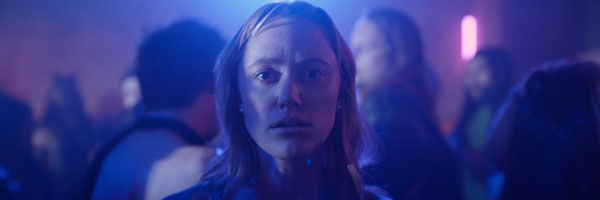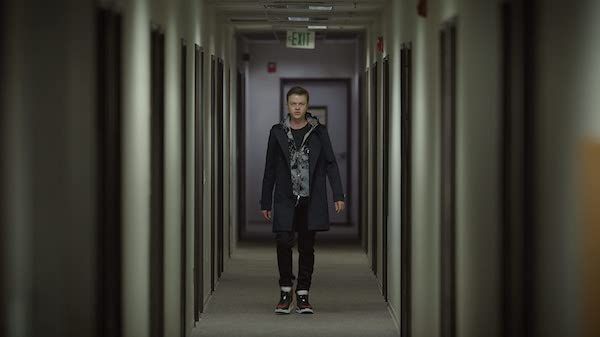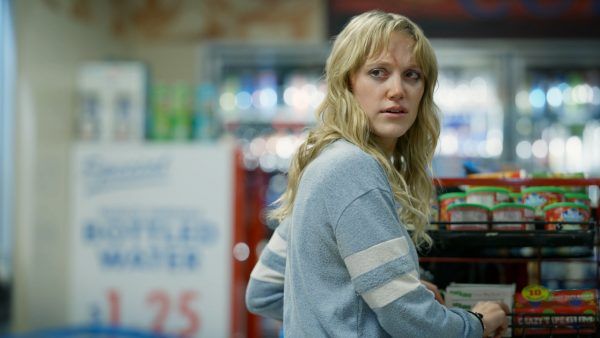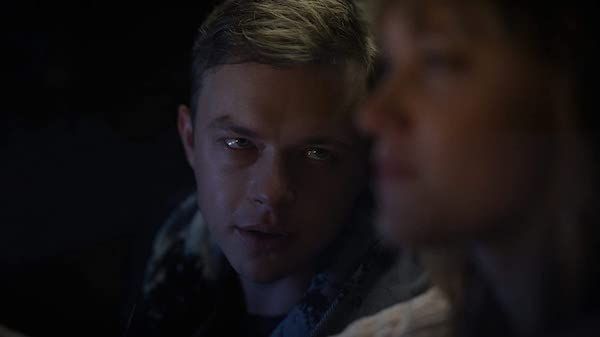Ah, the long take. In a form defined by the "edit," that invisible/visible mode of switching vantage points rapidly, subconsciously/consciously reminding us what we're watching isn't real, the long take sneaks in the back of our brains and says, "Yeah, but it kind of is, though." If there are any edits in one of these unbroken pieces of cinematographic magic tricks, they're obscured; all the better to present the sudden illusion that what we're watching is a chunk of unfettered reality (when in reality, it's very fettered by an entire professional film crew). We see them pop up in movies (i.e. the battle sequence in Children of Men), TV shows (i.e. the fight sequence in Daredevil), and even on occasion take up the entire length of a feature film (i.e. 1917). But when we see one pop up on a Quibi show, like it does in The Stranger, it demands our attention and thensome, given its unique presentation style of being simultaneously horizontally framed (i.e. a traditional "widescreen" image) and vertically framed (i.e. how you normally scroll on your phone).
In episode four of The Stranger, a sharp thriller series directed sharply by Veena Sud, with cinematography from Paul Yee, our villain Carl E. (Dane DeHaan) has our hero Clare (Maika Monroe) right where he wants her — grabbing her throat through her apartment building's elevator doors. When Clare manages to escape his literal clutches, she rushes into her car and takes to the streets of LA to escape, eventually deciding in a panic to find literal sanctuary in a church service. And here is where our long take begins — from the moment Clare zooms through LA in her SUV to the moment she leaves the church building only to stumble upon Carl E's next plan, Sud and Yee frame it all as an unbroken, lurching, handheld tour de force of suspense. Brian De Palma showing up suddenly in a Quibi series? I love it!
I first watched the episode horizontally, in a widescreen presentation I'm used to from, like, my entire life of watching movies and TV. And I was genuinely impressed by the episode's organic confidence and audacity in its long take, especially as it related to Quibi's form of shortened episodes (giving up more than half of your 9 minute runtime to a single shot is risky, and its success should show Quibi what the shortened episode format can do successfully). It didn't feel shoehorned in — the series is presented in real-time, which each episode being simply titled after the next hour we find ourselves in; as such, a one-take sequence feels like a logical formal conclusion. The aesthetic, thematic, and horrific ideas communicated in this sequence reminded me a touch of what Leigh Whannell did in some of his Invisible Man sequences, especially with its use of negative space.
Because Carl E. is nowhere to be found explicitly within the frame, we assume he's implicitly lurking somewhere in this one-take's shadows, or even in the broadly fluorescent lights of the church building. I was very aware of Clare's setting throughout the horizontal version of this sequence; every change in location (the car, outside, the church building, a bathroom, and back again) and change in color temperature (pitch-black, pale blues, blinding whites, sickly pinks, and back again) provoked a visceral reaction in me. I steeled myself for where and how Carl E. would, or even could show up in these real-time location shifts. And I reveled in the filmmaking chops of Sud and Yee throughout.
There was a sense of feeling "in control" throughout the traditionally-framed version of this sequence, of climbing aboard a roller-coaster that I know Sud and Yee are in control of, allowing myself to suspend my disbelief just enough to enjoy the thrill ride while knowing that I'm in "safe" hands. Sud and Yee know this about their viewer, especially one as saturated in contemporary filmmaking techniques and classical aspect ratios as myself, and do their damndest to disorient me. When Clare locks herself in a bathroom stall, the fast-paced action slows suddenly, and this one-take sequence suddenly pivots into a quiet character beat of Clare calling her mom and tearfully explaining what's going on. It's an exquisite misdirect of what we usually expect in "action-oriented" oners, and the fact that this backstory-revealing moment is immediately followed up by one of the scariest-framed moves in the whole thing is doubly disorienting.
Sud and Yee take full advantage of their wider frame in this moment, Clare suddenly being surrounded and shoved in the corner by the pastel pinks and blues of this "friendly" seeming bathroom wall and door — until the blood red sneakers of Carl E. (and the blood red of, um, a bloody knife) pop in and disrupt what we assumed was safe and empty. I love how Sud and Yee manage to sneak in a "traditionally framed and edited shot/reverse-shot" sequence in the middle of their sequence that literally has no (visible) edits, using the power of a wider frame as their "edit points." Clare is positioned hard frame left, staring at "something." Instead of cutting to that "something," the camera tracks across the empty desert of the blue bathroom door, landing on a knife stabbed through it positioned hard frame right. And then, when Clare opens the door to get a better look, the camera tracks backward to settle them in a two-shot on either side of the frame. All of this could've been traditionally covered and cut, but Sud and Yee did it all in one by taking advantage of their wide frame. Filmmaking is cool!
But is filmmaking still "cool" in a vertical aspect ratio? The answer is "yes, but in a pretty wildly different way!" I'm not gonna lie, I'm not used to watching professionally crafted content in a vertical aspect ratio on my phone in the palm of my hand — and I think that level discontent plays to the newly framed sequence's advantage. There's a lack of control and familiarity in the vertically presented one-take; instead of feeling like I'm watching an immaculate piece of carefully-crafted cinema, I feel like I'm watching a voyeuristic, subjective, "in the thick of it" piece of caught footage. The vertical frame makes it feel like someone is with Clare capturing this on their phone as she runs through this, the camera itself becoming a character in a way the wider frame simply never could. The handheld jerks jerk harder, the swishes across settings feel more amorphous and jarring, the closeups feel more invasive. What we lose in "clarity" and "purpose," we make up for in "subjectivity" and "rawness."
The vertical framing does clip the wings of setting and negative space being able to generate terror and intrigue (because the frame simply is not wide enough to do so), but in its place, Sud and Yee's frame finds a nearly overwhelming focus on its protagonist as the primary generator of intrigue. We simply can't make heads or tails of what's going on around Clare — our POV is just too cramped, confusing, and chaotic to do so — but we always know how Clare is feeling, in a way that the more traditional frame sometimes removes us from. By the time we push in on Clare during her quiet, tragic phone call with her mom, I feel genuinely uncomfortable in watching. I'm less paying attention to the direction and more feeling icky that I'm getting shoved headfirst into this obviously private moment. The "fun" of staging traditionally edited filmmaking tropes within a sequence lacking edits is gone, but in its place comes an obsessive, scary, intensely personal dive into the headspace of a desperate human.
Both modes of this one take sequence are compelling to watch, no doubt. And each contains its own unique pleasures and thrills, that I might broadly differentiate being "directorial" and "emotional" in nature. With this one-take framed in decidedly different ways with decidedly different results, I can't wait to see what future filmmakers do with this opportunity — whether their choices involve edits or not.
The Stranger is now streaming on Quibi.
This article is presented by Quibi.




